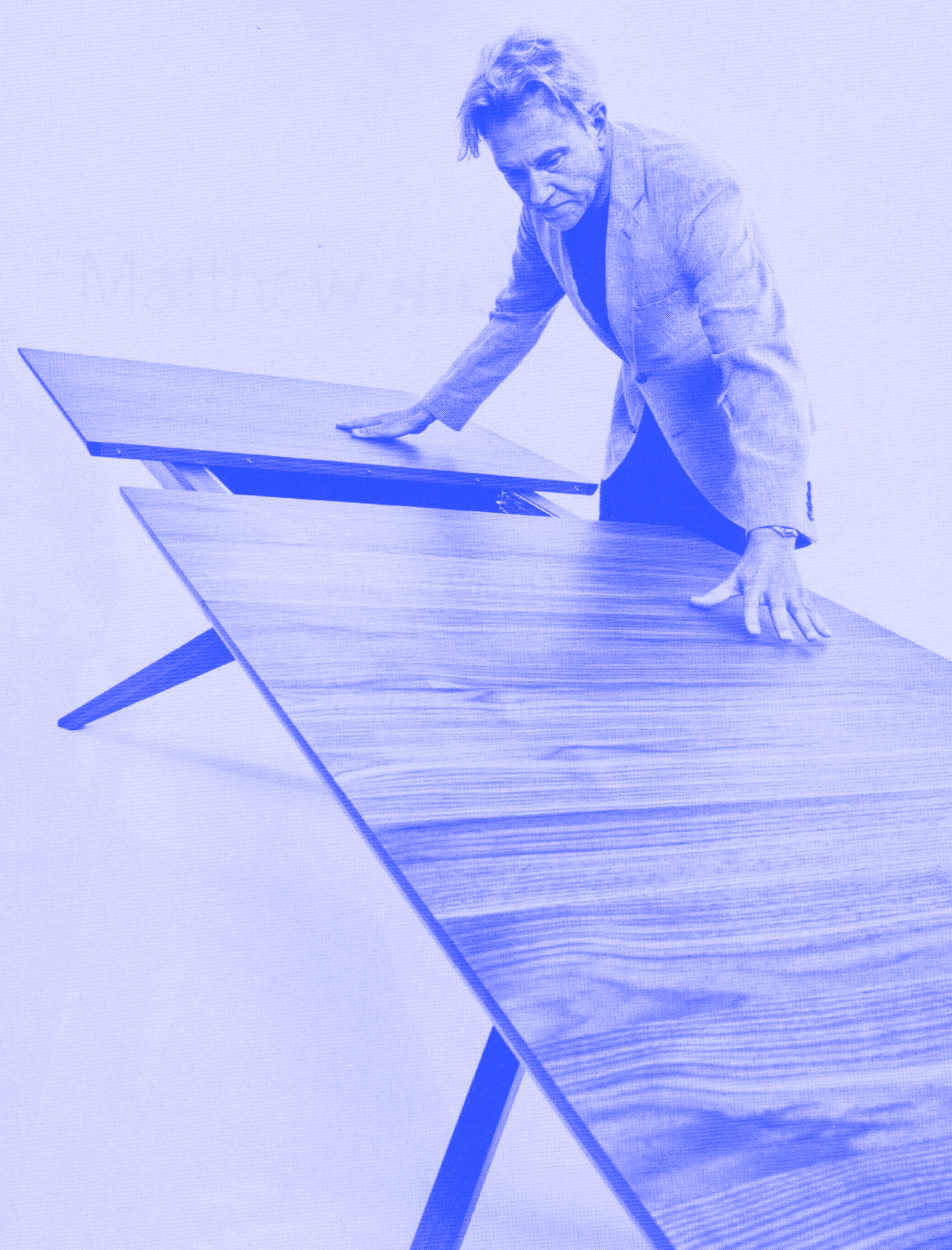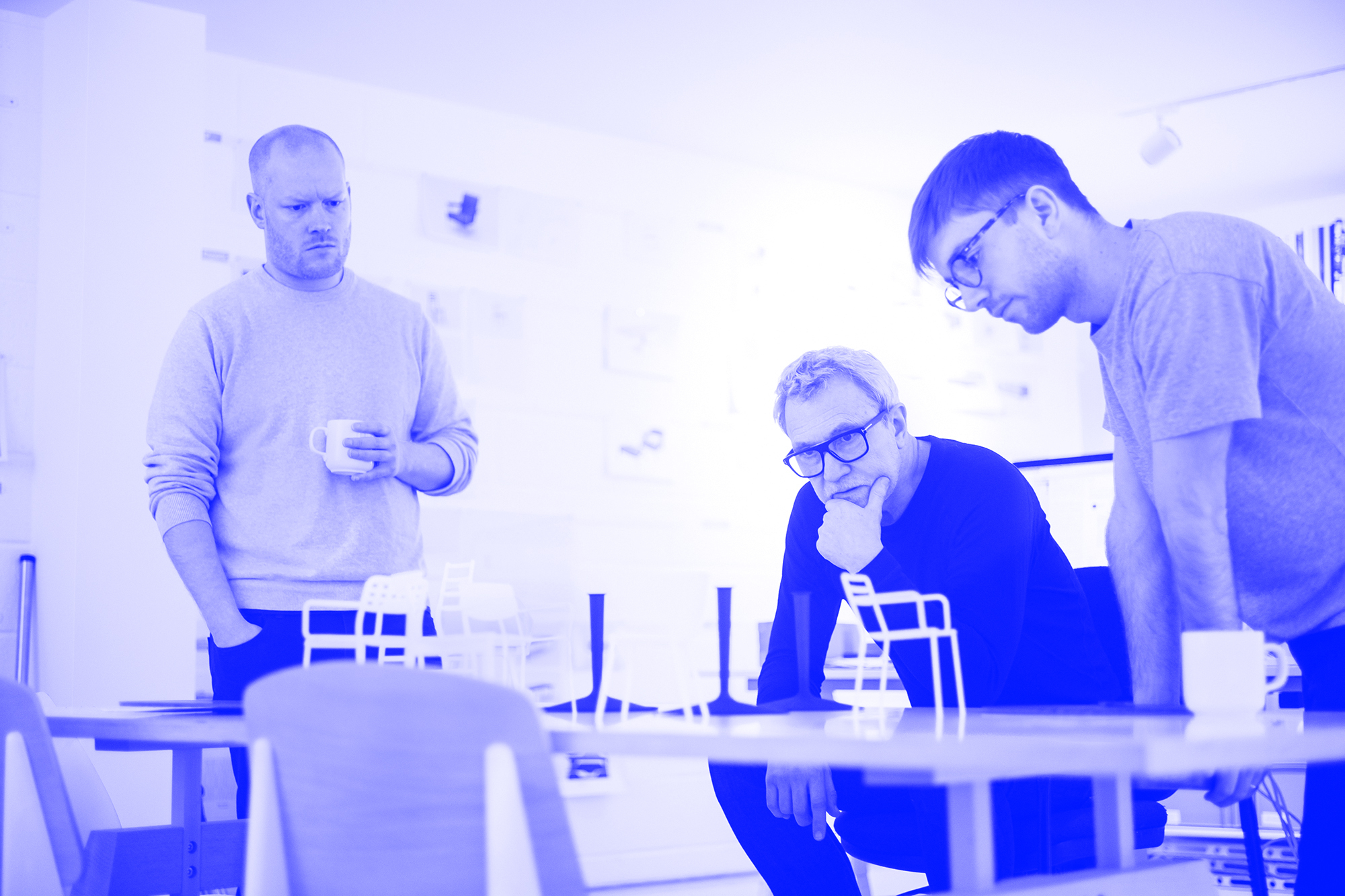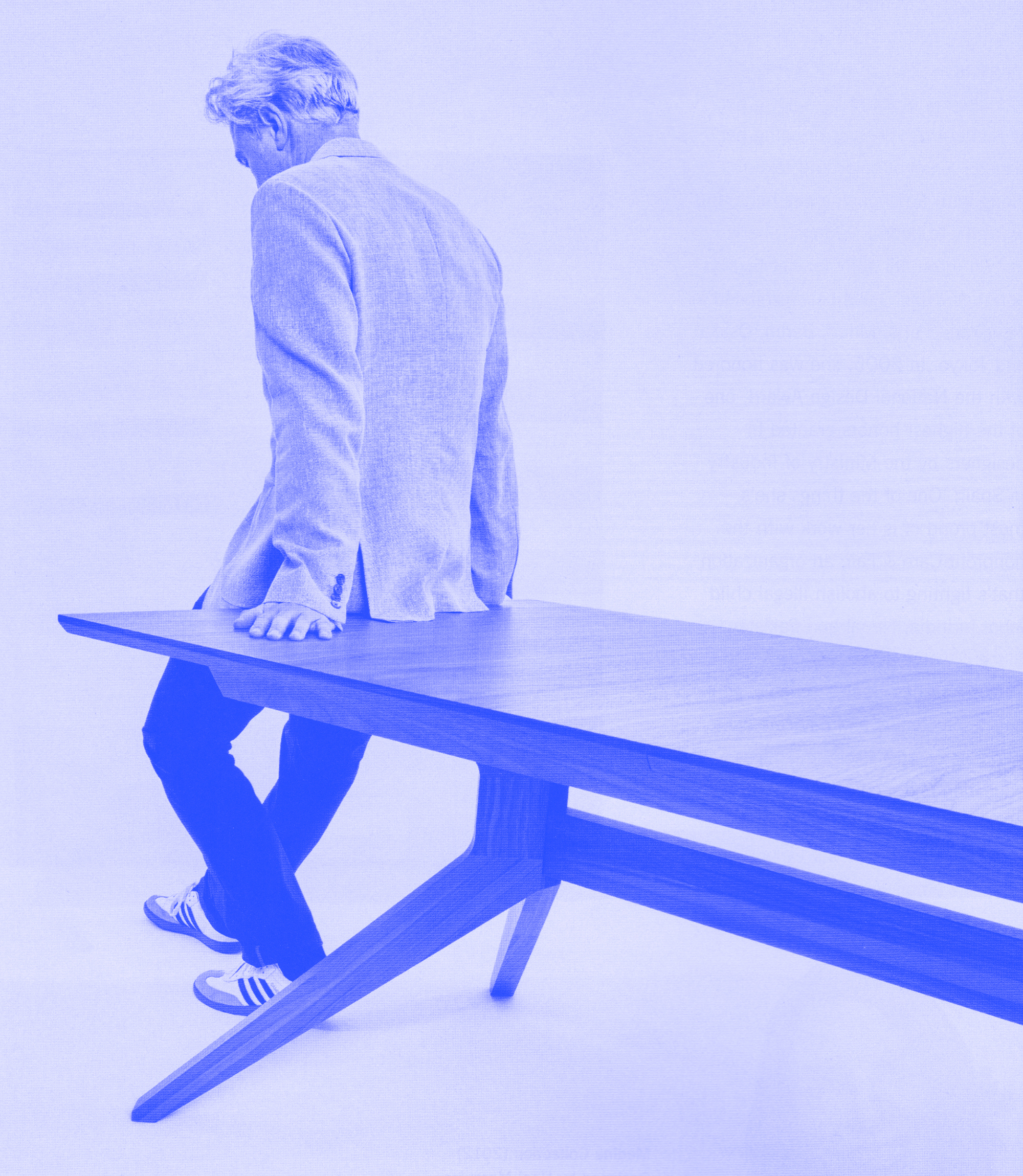Ethos
Matthew Hilton Studio is a design consultancy based in London, UK. We work across a range of furniture, lighting and product design. The studio members are Matthew Hilton, David Britton and Harry Hasson.
Below is an interview by Grant Gibson that took place in the summer of 2019:
-

It’s 2007 on the eve of 100% Design (then the premiere event in the UK design calendar) and Matthew Hilton is about to launch himself as a new ‘lifestyle’ brand with a range of timber furniture. However, all is not well. The pieces that he has manufactured in Sri Lanka (after visiting the factory on a number of occasions) are stuck in customs. On the morning of the show he has to drive a van to the Suffolk coast and unload his container. But the work hasn’t been packed properly and as a result has warped and cracked. As he sits across a table from me in his Crystal Palace-based studio, he flinches, almost imperceptibly, at the memory. ‘I’d expected the delivery a fortnight before. When I think about it now it was just horrendous.’
Strangely though this moment of abject panic became the making of the studio. Despite the last minute adjustments the new pieces were well received by visitors and media alike, retailers were beginning to talk numbers. The collection even picked up an award at the show. ‘There was a really good vibe but I was thinking: “How am I going to make this stuff?”’ The episode persuaded Hilton that the rigmarole of manufacturing, marketing and retailing his own ideas wasn’t for him. At the same time Luis De Oliveira from Portuguese manufacturer De La Espada arrived on his stand, offering a licensing deal for the work. The designer wasn’t entirely convinced. At that time the company was producing furniture in walnut and oak that was high quality but could hardly be described as cutting edge. On the plus side Hilton says: ‘It had a really highly skilled workforce.’
However, the opportunity to make his pieces in Europe, the ambitious plans De Oliveira had for the brand, and the ability of the firm’s artisans won him over. Hilton signed up and a pivotal relationship for his nascent company was created. The practice as it stands today with Hilton working alongside Dave Britton and Harry Hasson began to take discernible shape.

Scroll forward 12 years from that day at 100% Design and the trio seem comfortable in their own skins. It may be Hilton’s name above the door but they are all keen to emphasise the studio’s collaborative nature. ‘It has become more of a group thing than it was,’ he explains. ‘Generally we have a discussion about the brief. It’s a way of working out what the product is and what the company is about. We need to discover what the manufacturing constraints are and the brand’s place in the market. Sometimes the brief needs pinning down more precisely. That provides the framework.’ Subsequently an idea either emerges rapidly or all three will sketch – Hilton on paper, Britton and Hasson digitally – before one of the team takes charge of the project. ‘That said all three of us are involved sufficiently that should the person in charge not be around anybody can pick it up,’ says Britton. The studio has 30 to 40 projects on the go at any one time, which seems startling, though as Hasson points out: ‘It sounds a lot but everything will be at different stages.’
Increasingly too the trio are doing speculative work, rather than waiting for projects to come in from clients. There is some pragmatic thinking behind this. ‘We want to bring an idea for a product to a client in as resolved as state as it can possibly be,’ explains Hilton. ‘It means there’s less room for misunderstanding or miscommunication as the process continues. But that doesn’t preclude change. Design is about compromise but it’s compromise that’s very controlled.’

The furniture and products that come out the other end of this process reflect the character of the studio itself. By and large it’s pieces tend to be thoughtful and unfussy, while at the same time still being contemporary. When I ask about its aesthetic all three look briefly bemused. Hilton points to a group of sketches pinned to the adjacent wall and says: ‘I suppose we must have an aesthetic but if you look at all these I don’t know if you’d say that they all come from the same studio.’ ‘There are things that come up in our work quite often,’ counters Britton. ‘If you look at the silhouettes we produce there’s often a distinct form. But it’s a subconscious result of our process and the way with think through each project I suspect.’
The aesthetic of a product is born out of the relationships the designers broker with their clients, which include Benchmark and Case, as well as De La Espada. ‘We always talk to our client about their own company and go and see their factory to work out how things are made,’ says Hasson. It’s a process of understanding the capabilities and limitations of the company in question. ‘We have a pretty wide understanding of manufacturing techniques. We know what’s going to be makable and that’s key,’ adds Britton.

Making is a vital part of Hilton’s back story. He initially learned about furniture design while doing foundation at Portsmouth Art College, having briefly tinkered with the notion of working in fashion, in part thanks to his love of David Bowie. After studying 3D design at Kingston University, he got a job making models for CAPA , a product design company founded by Bob Cross and John Almond, briefly working alongside a young Dick Powell (later of Seymour Powell fame). ‘The company’s clients included Apricot, a British computer company and the architect Kit Allsopp, so I used to make models of monitors and keyboards as well as architectural stuff,’ he recalls. Meanwhile at the weekends he busied himself designing and making candlesticks that quickly piqued the interest of retailers such as Joseph, Liberty of London and Heal's. These were produced in cast aluminium by a string of local artisans. ‘I’d sit on the floor of the kitchen, clean them, put them in a bag and deliver them myself.’
Subsequently when Cross and Almond dissolved their partnership, he took over the workshop himself and began creating more products as well as doing some shopfitting for Whistles and Paul Smith. ‘I was definitely frustrated at working for someone and I wanted to make my own stuff,’ he says. It was still a brave decision. It’s worth pointing out quite how different the cultural landscape was in the UK through much of the eighties and nineties. Nowadays, in our cities at least, design has become an integral part of our lifestyles. The industry has a media and marketing infrastructure.

Back then though design was at best a minority interest. Prince Charles was railing against contemporary architecture, and former Conservative minister Alan Clarke could insult Michael Heseltine by describing him as ‘someone who buys his own furniture’. The late (and much missed) designer James Irvine once told me that he was so disillusioned by the launch of the Mini Metro in 1980 and what it said about the state of the British manufacturing industry that he felt he had no option but to decamp to Milan. ‘It felt like a bit of a fight,’ confirms Hilton, ‘and that was a bit of motivation. I used to get frustrated and cross that things were so crap. Products weren’t as easily found then. There weren’t many stores selling “designed” objects and the Internet didn’t exist. So when I saw an Alessi coffee maker I was amazed.’
He first met SCP’s Sheridan Coakley in 1986 at an exhibition of his work at Joseph, that included a table, shelves, candle sticks, ceramics and bowls made from spun copper. Coakley had founded his company the year before and was on the look out for new British talent. Suitably impressed he decided to take Hilton’s shelves to the Milan Furniture Fair, along with pieces by the up-and-coming Jasper Morrison and a working partnership was forged that continues to this day.

Five years later Hilton designed what has become a career-defining chair for SCP. The brief for the Balzac was simple. ’Sheridan wanted a modern version of a big leather club chair. That was it,’ remembers Hilton. His design carried a hint of art deco about it but also felt bang up to date – familiar but contemporary. Happily too, the piece was wonderfully comfortable. Surprisingly perhaps it took the Balzac a couple of years to find a market, only really taking off commercially when Sir Terence Conran spotted it on a stand in the Cologne Furniture Fair in 1993. Quickly though it became an object of choice for a burgeoning new generation of loft-livers. Nearly 30 years later it’s still selling in droves. That kind of success can throw a career out of kilter and I wonder if the chair became something of an albatross around the designer’s neck? ‘There was a time when I was a bit fed up of people thinking that all I can do is design upholstery,’ he smiles. ‘But now I think it’s lovely to have something that has been in production for that long. I’m really proud of it.’
The success of the Balzac might not have transformed him into a household name like, for example, Philippe Starck but it had provided Hilton with a certain profile and media cachet. So it came as a bit of a surprise when he decided to take a job as head of furniture at Habitat. At the age of 43 it was only the second time he’d taken a regular salaried position and I sense he craved the financial stability it offered. He learned plenty too, he says. Habitat was owned by IKEA at the time and he watched how a global corporation goes about its business, picking up a slew of new contacts in the supply chain. After four years though he realised he needed his independence back… which is when he came up with the notion of starting his own brand.

Right now you sense that the studio is in a good place. The trio has a small roster of good clients, with whom they have invested time and emotional energy building a relationship. ‘We need to be working with companies that are the best fit we can find,’ Hilton tells me. ‘I don’t want to just design one chair for a manufacturer. It’s pointless.’ Instead it’s a question of understanding a firm’s soul, what it is capable of and perhaps gently pushing it forward into the future. At a time when so much of the design world appears more interested in marketing than making, and when products and interiors are created specifically to please users of Instagram, this seems like such a wonderful way to work.